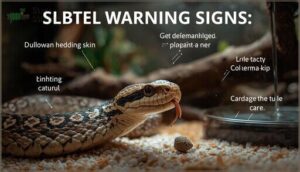This site is supported by our readers. We may earn a commission, at no cost to you, if you purchase through links.
Most snake owners don’t realize their pet is sick until symptoms become severe, and by then, treatment options narrow considerably. Unlike dogs or cats, snakes mask illness as a survival instinct, making early detection incredibly challenging. You might notice your ball python refusing meals or your corn snake breathing with its mouth open, but these signs often indicate problems that started weeks earlier.
The good news is that understanding how to prevent snake health issues transforms you from a reactive owner into a proactive caregiver. When you master habitat setup, establish consistent hygiene routines, and recognize subtle behavioral changes, you’ll dramatically reduce your snake’s risk of respiratory infections, parasites, metabolic bone disease, and other common conditions that shorten reptile lifespans.
Table Of Contents
- Key Takeaways
- Why Preventing Snake Health Issues Matters
- Setting Up a Healthy Snake Habitat
- Essential Hygiene and Cleaning Practices
- Nutrition and Feeding Tips for Snake Health
- Recognizing Early Signs of Health Problems
- When and How to Consult a Reptile Veterinarian
- Frequently Asked Questions (FAQs)
- How can I tell if my snake is sick?
- What are some specific symptoms of common illnesses in snakes?
- Why is shedding a concern for snake health?
- What are some signs of respiratory problems in snakes?
- What are some behavioral changes that may indicate snake illness?
- When should I seek veterinary care for my snake?
- How to prevent disease in snakes?
- How do I keep my snake healthy?
- What is the best thing to prevent snakes?
- How do you know if a snake is unhealthy?
- Conclusion
Key Takeaways
- Early illness in snakes often goes unnoticed, so spotting subtle behavioral changes and acting quickly is essential for effective treatment.
- Proper habitat setup—covering enclosure size, temperature, humidity, and safe substrates—plays a major role in preventing common health issues.
- Consistent hygiene routines, including spot cleaning and safe disinfectants, sharply reduce the risk of infections, parasites, and respiratory diseases.
- Annual veterinary exams and strict quarantine for new or sick snakes are crucial for catching problems early and protecting your collection.
Why Preventing Snake Health Issues Matters
Healthy snakes rely on more than just basic care or luck. Preventing health issues puts you ahead of problems before they start and gives you real peace of mind. If you’re wondering what makes the biggest difference, it all begins with the right enclosure.
Benefits of Proactive Snake Care
A proactive approach to snake health weaves together early detection, enhanced wellbeing, and lifespan extension. Preventive care—like regular veterinary visits and precise habitat management—not just leads to behavioral improvements but also offers real economic advantages by cutting emergency costs.
When you invest up front, your snake thrives, stays active, and brings peace of mind with fewer surprises. Routine vet checks can help with early issue detection.
Risks of Neglecting Preventive Health Measures
Skipping preventive care puts your snake on a fast track toward trouble. Mortality rates rise when disease progression sneaks in—think respiratory infections turning fatal within weeks or parasitic neglect leading to death in under ten days. Miss preventative measures and you face:
Neglecting preventive care fast-tracks your snake toward fatal respiratory infections, parasitic death, and rapid health decline
Snakes can develop bacterial respiratory diseases, which can be life threatening.
- Quick decline from common health issues in snakes
- Metabolic outcomes like fractures or tremors
- Delayed treatment reducing recovery chances
Impact on Snake Lifespan and Wellbeing
When preventative measures slip through the cracks, snake health can spiral—shortening lifespan and erasing many years of potential enjoyment together. Snakes in stable, clean environments with proper snake care outlive those in neglected setups.
Habitat longevity isn’t just about large enclosures but consistent health management. The ties between wellbeing, proactive preventive care, and positive lifespan trends are impossible to ignore.
Setting Up a Healthy Snake Habitat
If you want your snake to thrive, creating the right living space is the first step. The essentials go far beyond just a glass box and a lightbulb.
Let’s look at what matters most when setting up a healthy habitat.
Proper Enclosure Size and Design
Imagine this: a snake unable to stretch fully, muscle tone fading, pacing at dusk—a scene all too common when minimum size standards aren’t met. You protect your snake’s body and spirit by prioritizing proper enclosure design.
- Choose a habitat at least as long as your snake.
- Add hides, perches, and secure ventilation.
- Exceed regulatory trends—favor evidence over tradition.
Maintaining Optimal Temperature and Humidity
While your snake may seem comfortable, ideal habitat conditions demand more than a quick glance. A basking spot anchored by accurate thermostat calibration forms the backbone of safe temperature control.
Use monitoring tools—like dual-probe hygrometers—to check both humidity gradients and ambient temperature. Seasonal adjustments keep enclosures’ humidity levels stable, making sure your snake’s health doesn’t hinge on guesswork about cage conditions.
Safe Substrate and Enrichment Options
Choosing the right substrate for your snake’s enclosure goes beyond simple habitat setup—it directly shapes environmental conditions and long-term health. Safe options like aspen shavings, coconut fiber, and newspaper reduce substrate impaction risk while supporting natural behaviors.
- Avoid pine, cedar, or fir: Risky substrate VOCs cause respiratory and neurological issues in up to 27% of exposed snakes
- Maintain cleaning substrate depth: 3–5 cm allows burrowing; replace fully every 4–6 weeks
- Preferred substrate types: Aspen and coconut fiber lower health complications by over 60%
- Add enrichment: Hides, branches, and deep substrate deliver enrichment brain benefits, boosting natural behaviors by 33–48%
- Monitor cage conditions: High-humidity substrates need biweekly inspection to prevent mold growth
Essential Hygiene and Cleaning Practices
A clean enclosure isn’t just about appearances—it’s your first line of defense against parasites, infections, and respiratory problems that can quickly compromise your snake’s health. You’ll need both regular maintenance and periodic deep cleaning to keep harmful bacteria, mold, and mites at bay.
Let’s break down the essential cleaning practices that will keep your snake’s environment safe and healthy.
Regular Spot Cleaning and Deep Cleaning Routines
Maintaining a clean enclosure isn’t just about appearances—it’s your first line of defense against bacterial infections and zoonotic risks like Salmonella. You should perform daily spot cleaning whenever you notice waste, shed skin, or uneaten prey, because feces left longer than 24 hours greatly increases bacterial growth. Deep cleaning, including complete substrate replacement and disinfection, should occur every 4–8 weeks to control pathogen buildup and maintain proper humidity levels.
Consistent enclosure management reduces waste buildup and keeps your snake healthier.
| Task | Cleaning Frequency | What to Do |
|---|---|---|
| Spot cleaning | Daily or as needed | Remove feces, urates, shed skin, uneaten prey |
| Water bowl maintenance | Every 1–2 days | Clean, disinfect, refill with fresh water |
| Substrate check | Weekly | Replace soiled areas, monitor for dampness |
| Furniture cleaning | As soiled | Wipe hides, branches if contaminated by waste |
| Deep clean | Every 4–8 weeks | Replace all substrate, disinfect surfaces, add fresh bedding |
Safe Cleaning Products for Snake Enclosures
The wrong disinfectant can do more harm than parasites themselves, so you’ll want products proven safe in veterinary settings. F10SC disinfectant and chlorhexidine solutions are trusted in reptile clinics, effective at proper dilution ratios without leaving toxic residue.
Natural alternatives like 3% hydrogen peroxide work well for routine hygiene.
Avoid ammonia-based cleaners and bleach—they compromise respiratory health and humidity levels even after applying mild soap and fresh bedding.
Preventing Mold, Mites, and Bacterial Growth
Think of your snake’s enclosure as a living ecosystem—small missteps breed mold, mites, and bacteria that compromise health in ways you won’t see coming. Five key practices drastically reduce contamination:
- Ventilate properly to drop mold incidence by 60% in humid habitats
- Replace substrate every 2–4 weeks for effective mite control
- Quarantine new snakes 30–60 days to isolate 95% of infestations
- Remove uneaten prey within 24 hours to lower bacterial counts by 55%
- Practice handler hygiene—wash hands before and after contact to reduce pathogen transmission by 78%
Daily spot cleaning catches visible waste before microbes multiply, while monthly deep disinfection keeps colonies below detectable thresholds.
Nutrition and Feeding Tips for Snake Health
Feeding your snake properly isn’t just about tossing in a mouse and calling it a day—it’s one of the most important ways you can prevent serious health problems down the line. Getting the prey size right, sticking to a consistent schedule, and understanding your snake’s nutritional needs will keep them at a healthy weight and free from deficiencies.
Let’s walk through the key feeding practices that’ll help your snake thrive.
Choosing Appropriate Prey and Feeding Schedules
You need to match prey size to your snake’s thickest body section, ensuring safe swallowing and proper snake nutrition. Hatchlings generally eat every 5–7 days, juveniles every 7–10 days, and adults every 10–21 days based on their dietary needs.
Frozen prey reduces injury risk compared to live prey, while maintaining dietary variety with appropriate prey items fosters a balanced diet and ideal feeding schedule.
Preventing Obesity and Nutritional Deficiencies
Your snake’s obesity risk climbs when captive diet analysis reveals feeding too frequently or offering prey that’s too large. Wild prey mimicry matters—aim for one meal approximating 10% of body weight, matching natural feeding schedules.
Body condition scoring through palpation helps you catch weight gain early, while supplementation strategies addressing vitamin D3 and thiamine prevent nutritional deficiencies that compromise snake nutrition and your pet’s balanced diet.
Safe Feeding Practices to Avoid Injuries
Beyond diet balance, how you present prey items determines whether feeding time stays safe or turns dangerous. Feeding myths aside, proper prey size and feeding tools matter more than your feeding schedule alone. Here’s what works:
- Always thaw prey completely to 98.6°F before offering—cold food triggers digestive issues.
- Use feeding tongs, never your hands, to present rodents and eliminate bite risk.
- Choose frozen-thawed over live prey to prevent 100% of defensive wounds.
- Supervise feeding from start to finish, catching choking or complications immediately.
Your snake diet thrives on prevention, not luck.
Recognizing Early Signs of Health Problems
Spotting health problems early can make all the difference in your snake’s recovery and long-term wellbeing. You’ll need to watch for subtle shifts in behavior, eating habits, and physical condition, since snakes often hide signs of illness until problems become serious.
Let’s look at the key warning signs that should prompt you to take action.
Changes in Appetite, Weight, or Behavior
How do you know when something’s truly wrong? Changes in appetite, such as refusal of food for more than four weeks, often signal underlying illness. Weight loss exceeding 10% of baseline body mass requires immediate attention, while abnormal movements or persistent lethargy indicate potential neurological or systemic problems. Early detection through weekly monitoring of these behavioral changes can prevent serious complications.
| Warning Sign | What to Watch For | Action Needed |
|---|---|---|
| Appetite Changes | Refusal of food beyond 4 weeks, outside shedding cycles | Schedule veterinary exam within days |
| Weight Loss | Loss exceeding 10% of normal body weight | Immediate diagnostic evaluation required |
| Activity Levels | Prolonged immobility, reduced exploration, loss of typical behaviors | Monitor closely; consult vet if persists |
| Abnormal Movements | Twisting, contorting, unusual posture patterns | Urgent veterinary attention for neurological assessment |
Identifying Skin, Mouth, and Shedding Issues
Watch your snake’s appearance closely between sheds. Skin lesion ID begins with noticing scale discoloration, crusting, or blisters that signal fungal disease or scale rot. Mouth rot signs include visible pus, blood, or jaw swelling requiring immediate care.
Shedding problems manifest as:
- Incomplete shed with retained patches
- Cloudy eyes persisting beyond normal pre-shed timing
- Increased shedding frequency without explanation
- Scale margin erosion or color changes
Address skin conditions and abnormal shedding promptly to prevent systemic infection.
Detecting Respiratory and Digestive Concerns
How often do you check your snake for breathing abnormalities like wheezing, gurgling, or open-mouth breathing? Respiratory infections strike up to 26% of tested snakes, particularly boas and pythons.
Digestive problems show as anorexia signs, regurgitation risks, or weight changes.
Early detection through fecal analysis and recognizing symptoms of illness improves survival dramatically, with proper quarantine reducing infection rates from 68% to just 4%.
When and How to Consult a Reptile Veterinarian
Finding the right veterinary care for your snake isn’t something you want to leave to chance. Not all vets have experience with reptiles, so you’ll need to do a bit of homework before an emergency strikes.
Let’s walk through how to find a qualified reptile vet, when to schedule checkups, and how to handle quarantine situations.
Finding a Qualified Reptile Vet
Finding the right reptile veterinarian isn’t something you can leave to chance—your snake’s life may depend on it. Start by confirming the veterinarian holds ABVP certification in Reptile and Amphibian Practice, then verify the clinic has specialized equipment like appropriately sized endoscopes and temperature-controlled surgical areas.
Ask about their weekly caseload with snakes and whether they offer owner screening consultations to review husbandry before problems arise.
Scheduling Regular Wellness Exams
You should schedule routine vet visits annually for your snake, though senior, breeding, or recovering snakes benefit from semi-annual exams to catch problems early. Standard components include physical assessment, fecal testing, and sometimes bloodwork or X-rays for early detection of hidden disease.
Risk factors like prior illness or recent acquisition may require more frequent veterinary care.
Unfortunately, owner compliance remains low—many underestimate how preventive care protects snake health long-term.
Quarantine and Care for Sick or New Snakes
Think of quarantine as your first line of defense—every new or sick snake needs complete isolation in a separate room for three to six months.
You’ll prevent disease transmission by using dedicated tools, disposable substrates like paper towels, and disinfectants such as F10SC or diluted bleach.
Strict isolation protocols dramatically reduce disease prevalence in your main collection, protecting all your animals.
Frequently Asked Questions (FAQs)
How can I tell if my snake is sick?
Watch for appetite changes, skin abnormalities, breathing issues, and behavioral shifts—early detection saves lives.
Recognizing health problems like oral signs or lethargy helps you act before symptoms worsen, ensuring your snake stays healthy.
What are some specific symptoms of common illnesses in snakes?
Common health issues in snakes include respiratory infections with wheezing and mouth bubbles, mouth rot showing swelling and discharge, shedding problems with retained skin, parasites causing lethargy, and digestive troubles presenting as weight loss or abnormal stool.
Why is shedding a concern for snake health?
Shedding problems in snakes, like retained eyecaps or abnormal shedding periods, can cause vision loss, constriction risks at the tail, infections, and even zoonotic potential from bacteria-laden retained shed requiring immediate attention.
What are some signs of respiratory problems in snakes?
Respiratory infections often cause open-mouth breathing, wheezing, and excess mucus from the nose or mouth. You’ll notice difficulty breathing, postural changes like head elevation, appetite loss, and lethargy—clear signs requiring immediate veterinary attention.
What are some behavioral changes that may indicate snake illness?
Your snake’s suddenly acting like it’s in slow motion? Lethargy signs, feeding refusal, and hiding behavior often signal trouble.
Watch for posture changes and abnormal movements—these behavioral insights help you catch recognizing health problems early.
When should I seek veterinary care for my snake?
You’ll need emergency veterinary care if your snake shows labored breathing, refuses multiple meals, or displays unusual lumps.
Annual preventative checkups help detect issues early, while specialists offer diagnostic testing and quarantine protocols for new arrivals.
How to prevent disease in snakes?
Preventing snake health issues starts with proper husbandry standards, including ideal environmental conditions, enclosures humidity, and temperature control.
Regular veterinary checkups, strict hygiene importance, and quarantine protocols protect against zoonotic diseases while ensuring preventive care works.
How do I keep my snake healthy?
You’ll notice signs of thriving health when your snake’s eyes are clear, skin is vibrant, and appetite stays consistent.
Focus on proper snake habitat and care, balanced hydration importance, handling stress reduction, and enrichment needs.
What is the best thing to prevent snakes?
Nothing beats a proactive approach: sturdy fencing is most effective when paired with sealing entry points and smart yard management.
Repellents often fall short, so prevention is better than cure—combine these steps with trapping strategies for real peace of mind.
How do you know if a snake is unhealthy?
Lethargy signs, lack of appetite, and skin abnormalities like poor shedding are common health issues in snakes.
Respiratory symptoms, weight changes, and parasitic indicators such as mites all help with recognizing signs of illness or poor snake health.
Conclusion
What’s the difference between a snake that thrives for decades and one that fades away too soon? The answer lies in how to prevent snake health issues before they begin. Every temperature check, careful meal, and observant moment is a small act of protection.
You’re not merely keeping a reptile alive—you’re fostering its resilience. When safe routines become second nature, you don’t just lengthen your snake’s life; you make sure every day is lived in good health.
- https://static1.squarespace.com/static/6268f004e9da29777b080f8f/t/645aa4a4bce9de6feca4faab/1683661990992/FBH+Recommended+Minimum+Enclosure+Size.pdf
- https://www.sciencedirect.com/science/article/abs/pii/S0304401725000317
- https://pmc.ncbi.nlm.nih.gov/articles/PMC8516226/
- https://www.who.int/news-room/fact-sheets/detail/snakebite-envenoming
- https://www.thelancet.com/journals/lancet/article/PIIS0140-6736(23)01698-7/fulltext














